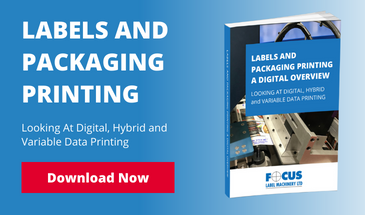
If you’re seeking high-quality professional label printing, it’s important that you choose the right type of label for your products. Self-adhesive and texture labels are two of the most common, both of which offer excellent print quality, durability, and cost-efficiency.
In this article, we look at companies that may be specialist in one sector, but have crossover potential & need to produce both garment labels & self-adhesive labels. The production techniques for both are similar.
We will explore the main features and differences between self-adhesive labels and textile labels.
Self-adhesive labels
Most self-adhesive labels are manufactured from a composite material with paper or film that has a self-adhesive backing, enabling them to be mass-produced for a low cost. Because of their portability and convenience, they are used in many applications, most commonly within the food industry but not exclusively. Other markets include chemicals, pharmaceuticals, petro-chemicals, retail, textiles & garments sectors.
Self-adhesive labels offer three important advantages:
-
Durability: Self-adhesive labels are durable and flexible, so they can be used on many surfaces including cans and plastics. They can withstand cold, heat, and abrasion, and rarely tear or peel off, giving users confidence that their products will be presented in the most attractive way possible.
-
Affordability: Far cheaper than other types of labels, self-adhesive labels deliver outstanding cost-efficiency as they can be bought in bulk at a much lower unit cost. Because the labels are applied directly to the product, they can be easily switched to specialty or time-limited products, thereby achieving excellent value for money. Also, they are highly customisable and, therefore, are suited to unique packaging solutions.
-
Time-friendly: Self-adhesive labels can be manufactured quickly and easily using analogue Flexo presses or digital equipment. Label application requires no specialist knowledge, so the process of sticking the labels to products is fast and simple – one of the main reasons why manufacturers like using self-adhesive labels. The market for labels & stickers is vast.
Textile labels
Textile labels are small labels that are sewn on the inside of garments. Made from nylon, polyester satin, or taffeta, these labels are universally used in all types of clothing and shoes. It’s a large market.
-
Customisable: Textile labels provide the consumer with vital information about the item of clothing that they are purchasing. Comprehensive details – text or graphics - can be easily printed onto the labels, such as fabric constitution, washing instructions in multiple languages, and country of manufacture. These are legal requirements for garments in most countries.
-
High-quality: Printing facilitates the highest standard of print quality, with no bleeding or distortion. This is particularly important as the text on textile labels tends to be on the smaller side, as little as 4pt high, so it must be legible to the consumer. Because garments will be regularly washed, ink mustn’t fade over time: All printed textile labels will need withstand heat, detergent, and international washing standards.
-
Cost-efficient: Higher volume Textile labels can be produced quickly using analogue printing presses which have been proven over the last 50 years. Low volumes can be produced cheaply using digital printing machines, such as thermal foil or Ink jet printers. Because fewer processes are involved, production time is a fraction of other printing methods while energy consumption is lower. By choosing digital printing for your textile labels, you can anticipate significant cost savings and higher profits.
Contact us for more information
If you’re looking for a reliable UK manufacturer and supplier of digital label printing machines, please get in touch with Focus Label on 01949 836223 or click here to send us an enquiry.







